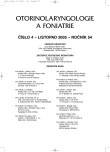Cholesteatoma and Fistula of Bone Labyrinth
Authors:
Viktor Chrobok 1; A. Pellant 1,2; E. Šimáková 3; K. Pokorný 1; A. Pollak 4
Authors‘ workplace:
Klinika ORL a chirurgie hlavy a krku, Krajská nemocnice Pardubice
; přednosta prof. MUDr. A. Pellant, DrSc.
Ústav zdravotnických studií, Univerzita Pardubice
1; přednosta prof. MUDr. A. Pellant, DrSc.
Fingerlandův ústav patologie, LF UK a FN, Hradec Králové
2; přednosta prof. MUDr. I. Šteiner, CSc.
ORL klinika, Univerzitní nemocnice, Zurich, Švýcarsko
3; přednosta prof. Dr. med. S. Schmid
4
Published in:
Otorinolaryngol Foniatr, 54, 2005, No. 4, pp. 193-198.
Category:
Original Article
Overview
Summary:
The authors evaluate seven patients with fistula of labyrinth, which were verified during 220 operations on patients with chronic middle ear inflammations with cholesteatoma at the ORL Department of Regional Hospital Pardubice from July 1997 till December 2002. Three patients suffered from vertigo already before the operation and two of them had even a positive fistula symptom; four patients were without vertigo. Two patients were deaf before the operation and one other patient had a partial facial nerve paralysis.
The therapy consisted in sanation (treatment) of the inflammation by the open technique with removal of the posterior wall of ear canal (canal wall down) and removal of the cholesteatoma matrix from the fistula. The fistula was detected six times on the lateral and once on the superior semicircular canal. In two patients, intracranial complications were diagnosed (subperiostal abscess in one patient and in second one pachymeningitis with periphlebitis of the sigmoid sinus). In five patients with preserved hearing before the operation, the hearing remained unchanged after the operation, air conduction decreased in one, improved air and bone conduction improved in another patient and a deterioration of the conductive and perception components of hearing deteriorated in the other patient. The paralysis of facial nerve diagnosed in one patient before the therapy improved after the operation.
The authors discuss present opinions on the pathophysiology of the origin of fistula on the basis of destruction of the labyrinth bone wall due to chronic middle ear inflammation, the way of performing of the fistula test and its diagnostic contribution, the classification and staging of the labyrinth fistula and the tactics of therapy.
Key words:
labyrinth fistula, cholesteatoma, fistula symptom.
Labels
Audiology Paediatric ENT ENT (Otorhinolaryngology)Article was published in
Otorhinolaryngology and Phoniatrics

2005 Issue 4
Most read in this issue
- Xerostomia: Etiology, Therapeutic Possibilities, Recommendation to Patients
- Shaver (Microdebrider) in Otorhinolaryngology
- Langerhans‘ Cell Histiocytosis and Its Manifestation in Temporal Bone (Eosinophilic Granuloma of the Temopral Bone)
- Cholesteatoma and Fistula of Bone Labyrinth
